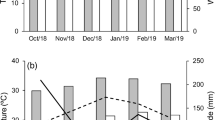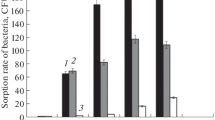Summary
The surface distribution ofAzospirillum on inoculated roots of maize and wheat is generally similar to that of other members of the rhizoplane microflora. During the first three days, colonization takes place mainly on the root elongation zone, on the base of root hairs and, to a lesser extent, on the surface of young root hairs.Azospirillum has been found in cortical tissues, in regions of lateral root emergence, along the inner cortex, inside xylem vessels and between pith cells. Inoculation of several cultivars of wheat, corn, sorghum and setaria with several strains ofAzospirillum caused morphological changes in root starting immediately after germination. Root length and surface area were differentially affected according to bacterial age and inoculum level. During the first three weeks after germination, the number of root hairs, root hair branches and lateral roots was increased by inoculation, but there was no change in root weight. Root biomass increased at later stages. Cross-sections of inoculated corn and wheat root showed an irregular arrangement of cells in the outer layers of the cortex. These effects on plant morphology may be due to the production of plant growth-promoting substances by the colonizing bacteria or by the plant as a reaction to colonization. Pectic enzymes may also be involved. Morphological changes had a physiological effect on inoculated roots. Specific activities of oxidative enzymes, and lipid and suberin content, were lower in extracts of inoculated roots than in uninoculated controls. This suggests that inoculated roots have a larger proportion of younger roots. The rate of NO− 3, K+ and H2PO− 4 uptake was greater in inoculated seedlinds. In the field, dry matter, N, P and K accumulated at faster rates, and water content was higher inAzospirillum-inoculated corn, sorghum, wheat and setaria. The above improvements in root development and function lead in many cases to higher crop yield.
Similar content being viewed by others
References
Baldani V L D, Baldani J I and Dobereiner J 1983 Effect ofAzospirillum inoculation on roots infection and nitrogen incorporation in wheat. Can. J. Microbiol. 29, 924–929.
Barak R, Nur I and Okon Y 1983 Detection of chemotaxis inAzospirillum brasilense. J. Appl. Bacteriol. 53, 399–403.
Barak R, Nur I, Okon Y and Henis Y 1982 Aerotactic response ofAzospirillum brasilense. J. Bacteriol. 152, 643–649.
Boddey R M and Dobereiner J 1982 Association ofAzospirillum and other diazotrophs with tropical gramineae. 12th International Congress of Soil Science New Delhi India 8–16 February 1982. Symposia Papers I pp 28–47.
Bowen G D and Rovira A D 1976 Microbial colonization of plant roots. Ann. Rev. Phytopathol. 14 121–144.
Brown M E 1982 Nitrogen fixtion by free-living bacteria associated with plants — fact or fiction?In Bacteria and Plants. Eds M Rhodes-Roberts and F A Skinner. Academic Press, London pp 25–41.
Dazzo F B and Truchet G L 1983 Interactions of lectins and their saccharide receptors in the Rhizobium-legume symbiosis. J. Membrane Biol. 73, 1–16.
Döbereiner J 1983 Ten years ofAzospirillum.In Azospirillum II. Ed. W Klingmuller Birkhauser Verlag, Basel, Boston Stuttgart pp 9–23.
Döbereiner J and De Polli H 1980 Diazotrophic rhizocoenoses. Annu Proc., Phytochem. Soc. Eur. 18 (Nitrogen Fixation), 301–333.
Foster R G and Bowen G D 1982 Plant surfaces and bacterial growth: The rhizosphere and rhizoplane.In Phytopathogenic Prokaryotes I. Eds M S Mount and G H Lacy. Academic Press New York pp 159–185.
Foster R C and Rovira A D 1976 Ultrastructure of wheat rhizosphere. New Phytologist 76, 343–356
Gafny R 1984 M.Sc. Thesis, Faculty of Agriculture, The Hebrew University of Jerusalem p 59.
Goodman R N 1982 The infection process.In Phytopathogenic Prokaryotes I. Eds. M S Mount and G H Lacy. Academic Press New York pp 31–62.
Harari A 1984 M.Sc. Thesis, Faculty of Agriculture, The Hebrew University of Jerusalem 60p.
Iino M, Yu R S T and Carr D J 1980 Improved procedure for the estimation of nanogram quantities of indole-3-acetic acid in plant extracts using the indolo-α-pyrone fluorescence method. Plant Physiol. 66, 1099–1105.
Inbal E and Feldman M 1982 The response of a hormonal mutant of common wheat to bacteria of the genusAzospirillum. Isr. J. Bot. 31, 257–263.
Kapulnik Y 1984 Ph.D. Thesis, The Hebrew University of Jerusalem 110p.
Kapulnik Y, Gafny R and Okon Y 1984 Effect ofAzospirillum spp inoculation on root development and NO −3 uptake in wheat (Triticum aestivum cv Miriam) in hydroponic systems. Can. J. Bot. 63, 627–631.
Kapulnik Y and Okon Y 1983 Benefits ofAzospirillum inoculation on wheat: effects on root development, mineral uptake, nitrogen fixation and crop yield.In Azospirillum II. Ed. W. Klingmuller. Birkhauser Verlag Basel Boston Stuttgart pp 163–170
Kapulnik Y, Okon Y, Kigel J, Nur I and Henis Y 1981 Effects of temperature, nitrogen fertilization and plant age on nitrogen fixation bySetaria italica inoculated withAzospirillum brasilense (strain Cd). Plant Physiol. 68, 340–343.
Kapulnik Y, Sarig S Nur I and Okon Y 1983 Effect ofAzospirillum inoculation on yield of field grown wheat. Can. J. Microbiol. 29, 895–844.
Kapulnik Y, Sarig S Nur I Okon Y Kigel J and Henis Y 1981 Yield increases in summer cereal crops of Israeli fields inoculated withAzospirillum. Expl. Agric. 17, 179–187.
Keen N T and Holliday M J 1982 Recognition of bacterial pathogens by plantsIn Phytopathogenic Prokaryotes. II. Eds M S Mount and G H Lacy. Academic Press New York pp 179–217.
Klement Z 1982 Hypersensitivity.In Phytopathogenic Prokaryotes II. Eds M S Mount and G H Lacy. Academic Press New York pp 149–177.
Lin W, Okon Y and Hardy R W F 1983 Enhanced mineral uptake byZea mays andSorghum bicolor roots inoculated withAzosprillum brasilense. Appl. Environ. Microbiol. 45, 1775–1779.
Lippincot B B, Whatley M H and Lippincot J A 1977. Tumor induction byAgrobacterium involves attachment of the bacterium to a site on the host plant cell wall. Plant Physiol. 59, 388–390.
Marshall K C and Bitton G 1980 Microbial adhesion in perspective.In Adsorption of Microorganisms to surface. Eds. G Bitton and K C Marshall. John Wiley & Sons. New York Chichester Brisbane Toronto pp 1–5.
Newman E I and Bowen H J 1974 Patterns of distribution of bacteria on root surfaces. Soil Biol. Biochem. 6, 205–210.
Nissen P 1971. Choline sulfate permease: Transfer of information from bacteria to higher Biological Systems. Ed. L Ledoux. North Holland, Amsterdam pp 201–212.
Okon Y 1982Azospirillum: Physiological properties, mode of association with roots and its application for the benefit of cereal and forage grass crops. Isr. J. Bot. 31, 214–220.
Okon Y 1984 Response of cereal and forage grasses to inoculation with N2-fixing bacteria.In Advances in Nitrogen Fixation Research. Eds C Veeger and W E Newton. Martinus Nijhoff, Dr. W. Junk, Pudoc Wageningen, The Hague pp 303–309.
Okon Y 1984 The physiology ofAzospirillum in relation to its utilization as inoculum for promoting growth of plants.In Nitrogen Fixation and CO2 Metabolism. Eds P W Ludden and J E Burris. Elsevier pp 65–174.
Okon Y, Albrecht S L and Burris R H 1977 Methods for growingSpirillum lipoferum and for counting it in pure culture and in association with plants. Appl. Environ. Microbiol. 33, 85–88.
Okon Y and Hardy R W F 1983 Developments in basic and applied biological nitrogen fixation.In Plant Physiology — A Treatise Vol VIII. Ed. F C Steward. Academic Press, New York pp 5–54.
Okon Y, Heytler P G and Hardy R W F 1983 N2 fixation byAzospirillum brasilense and its incorporation into hostSetaria italica. Appl. Environ. Microbiol. 46, 694–697.
Okon Y, Nur I and Henis Y 1983 Effect of oxygen concentration on electron transport components and microaerobic properties ofAzospirillum brasilense.In Azospirillum II. Ed. W Klingmuller, Birkhauser Verlag Basel Boston Stuttgart pp. 115–126.
Old K M and Nicolson T H 1975 Electron microscopical studies of the microflora of roots of sand dune grasses. New Phytologist 74, 51–58.
Patriquin D G 1981 New developments in grass-bacteria associationsIn Advances in Agricultural Microbiology. Ed. N S Subba Rao. Oxford and IBH Publishing Co., New Delhi pp. 139–190.
Patriquin D G and Dobereiner J 1978 Light microscopy observations of tetrazolium-reducing bacteria in the endorhizosphere of maize and other grasses in Brazil. Can. J. Microbiol. 24, 734–742.
Patriquin D G, Dobereiner J and Jain D K 1983 Sites and processes of association between diazotrophs and grasses. Can. J. Microbiol. 29, 900–915.
Reynders L and Vlassak K 1982 Use ofAzospirillum brasilense as biofertilizer in intensive wheat cropping. Plant and Soil 66, 217–223.
Rovira A D 1956 A study of the development of the root surface microflora during the initial stage of plant growth. J. Appl. Bacteriol. 19, 72–79.
Rovira AD 1970 Plant root exudates and their influence upon soil microorganisms.In Eds K F Baker and W C Snyder. Ecology of Soil Borne Plant Pathogens. California UP, Berkeley pp 170–184.
Sarig S, Kapulnik Y, Nur I and Okon Y 1984 Response of non-irrigatedSorghum bicolor toAzospirillum inoculation. Expl. Agric. 20, 59–66.
Sarig S, Kapulnik Y and Okon Y 1985 Effect ofAzospirillum inoculation on nitrogen fixation and growth of several winter legumes. Plant and Soil 90, 335–342.
Schmidt E L 1979 Initiation of plant root-microbe interactions. Annu. Rev. Microbiol. 33, 355–376
Shimshick E J and Hebert R R 1979 Binding characteristics of N2-fixing bacteria to cereal roots. Appl. Environ. Microbiol. 38, 447–453.
Stoessl A and Venis M A 1970 Determination of submicrogram levels of indole-3-acetic acid a new, highly specific method. Analytical Biochem. 34, 344–351.
Suslow T V 1982 Role of root-colonizing bacteria in plant growth,In Phytopathogenic Prokaryotes I. Eds M S Mount and G H Lacy. Academic Press New York pp 187–223.
Tien T M, Dien H G, Gaskins M H and Hubbell D H 1981 Polygalacturonic acid transeliminase production byAzospirillum species. Can. J. Microbiol. 27, 426–431.
Tien T M, Gaskins M H and Hubbell D H 1979 Plant growth substances produced byAzospirillum brasilense and their effect on growth of pearl millet (Pennisetum americanum L.). Appl. Environ. Microbiol. 37, 1016–1024.
Umali-Garcia M, Hubbell D H, Gaskins M H and Dazzo F B 1980 Association ofAzospirillum with grass roots. Appl. Environ. Microbiol. 39, 219–226.
Vance C P 1983Rhizobium infection and nodulation: a beneficial plant disease. Annu. Rev. Microbiol. 37, 399–424.
Van Rensburg H J and Strijdom B W 1982 Root surface association in relation to nodulation ofMedicago sativa. Appl. Environ. Microbiol. 44, 93–97.
Yahalom E, Kapulnik Y and Okon Y 1984 Response ofSetaria italica to inoculation withAzospirillum brasilense as compared toAzotobacter chroococcum. Plant and Soil 82, 77–85.
Author information
Authors and Affiliations
Rights and permissions
About this article
Cite this article
Okon, Y., Kapulnik, Y. Development and function ofAzospirillum-inoculated roots. Plant Soil 90, 3–16 (1986). https://doi.org/10.1007/BF02277383
Issue Date:
DOI: https://doi.org/10.1007/BF02277383




